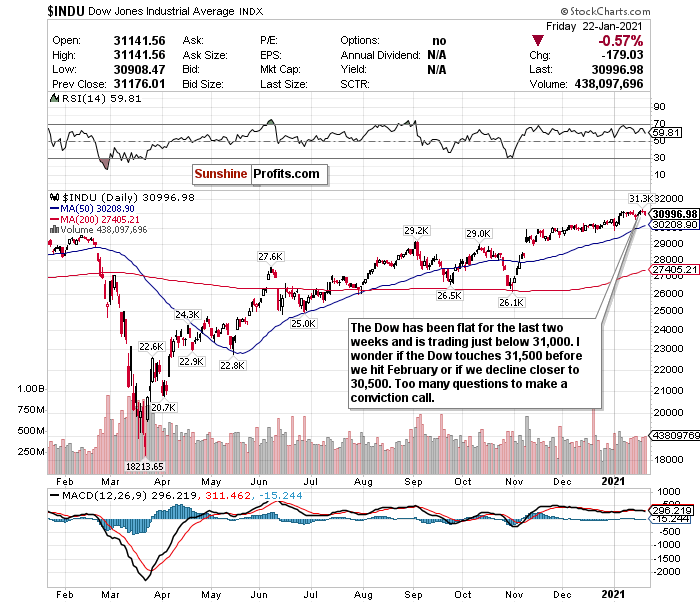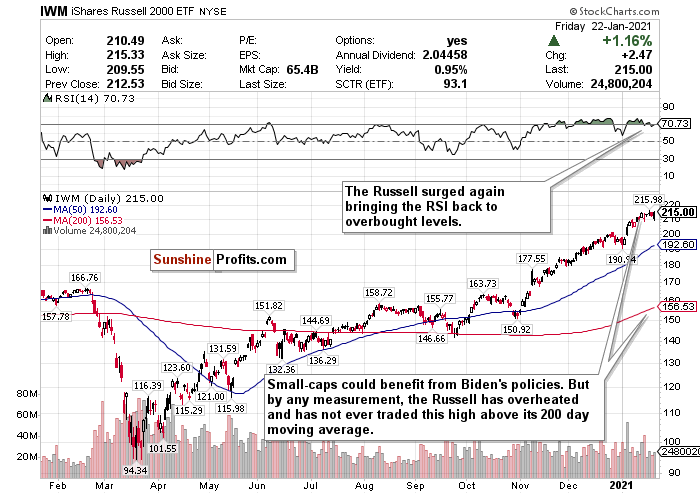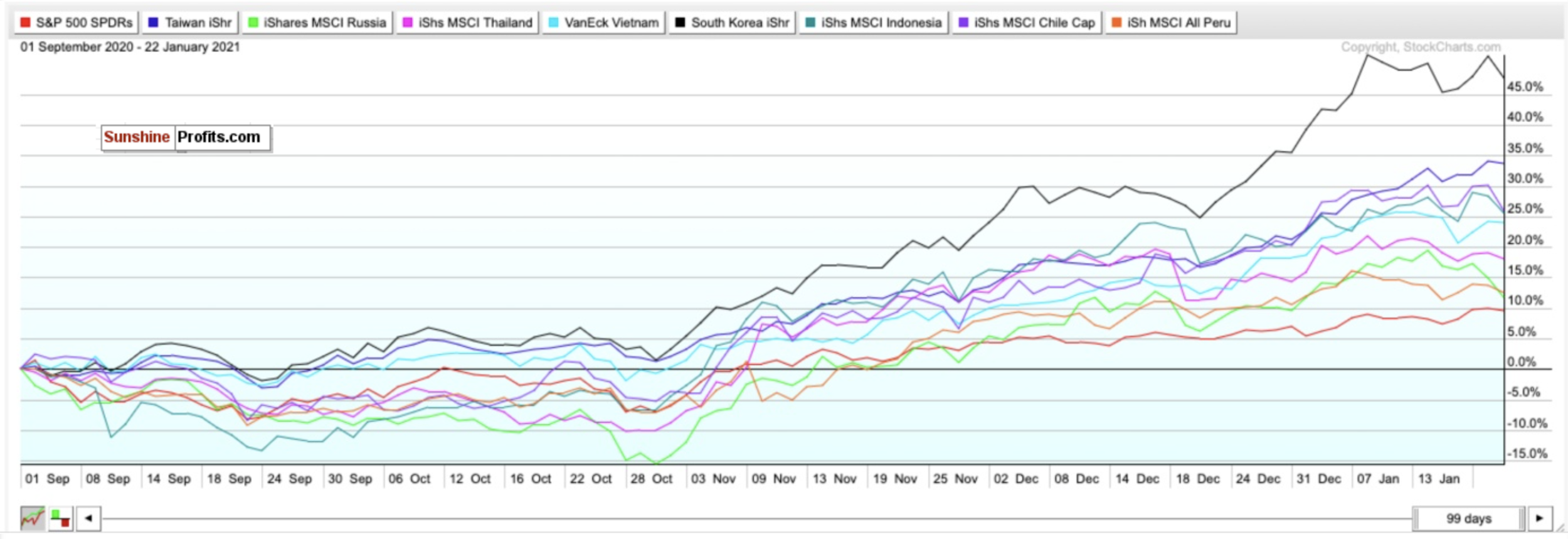Despite the Dow and S&P finishing the week slightly off record highs, the Dow still eked out a gain of around 0.6% for the week, while the S&P gained 1.9%.
What caught me off guard this week, though, was the Nasdaq. The Nasdaq surged by a healthy 4.2% and managed to close the week at an all-time high.
Come again?
Wasn't tech supposed to wither away and die thanks to be big bad Democrat boogeymen? Wasn’t the radical Biden tax agenda and regulatory framework supposed to send your favorite tech stocks plummeting? Wasn’t Biden’s tax plan supposed to take an estimated 5-10% off the earnings per share?
For now, it seems like the market is putting more of its hopes into Biden's $1.9 trillion stimulus plan and ignoring his tax and regulation plans. As Treasury Secretary and former Fed Chair Janet Yellen claimed, Biden's primary focus is aiding American families (i.e., stimulus, low-interest rates) and, for now, not raising taxes.
But nothing is for sure with this stimulus. Republicans will resist it, and some moderate Democrats may do so as well. With Vice President Kamala Harris as the only tiebreaker for a Democrat majority in the Senate, Biden needs all the support he can get to pass this aggressive stimulus.
I maintain my view that the market is too complacent, and that we are about to enter a correction at some point in the short-term. It still reminds me of the Q4 2018 pullback (read my story here).
For one, valuations are absurd. Tech IPOs are a circus, the S&P 500 is at or near its most-expensive level in recent history on most measures, and the Russell 2000 has never traded this high above its 200-day moving average.
While stimulus could be useful for stocks in the short-term, it could almost certainly mean the return of inflation too by mid-year. The worst part about it? The Fed will likely let it run hot. With debt rising and consumer spending expected to increase as vaccines are rolled out to the masses, the Fed is undoubtedly more likely to let inflation rise than letting interest rates rise.
Others, however, believe that the market reflects optimism that the global economy will recover with the eventual lifting of COVID-related restrictions and more widely-available vaccines. John Studzinski, vice chairman of Pimco, believes that market valuations are strong and reflect expectations of this eventual reopening and economic recovery by the second half of the year.
All of this simply tells me that the market remains a pay-per-view fight between good news and bad news.
We may trade sideways this quarter- that would not shock me in the least. But I think we are long overdue for a correction since we haven’t seen one since last March.
Corrections are healthy for markets and more common than most realize. Only twice in the last 38 years have we had years WITHOUT a correction (1995 and 2017).
A correction could also be an excellent buying opportunity for what should be a great second half of the year.
Therefore, to sum it up:
While there is long-term optimism, there are short-term concerns. A short-term correction between now and Q1 2021 is possible. I don't think that a decline above ~20%, leading to a bear market will happen.
In a report released last Tuesday (Jan. 19), Goldman Sachs shared the same sentiments.
My goal for these updates is to educate you, give you ideas, and help you manage money like I did when I was pressing the buy and sell buttons for $600+ million in assets. I left that career to pursue one where I could help people who needed help, instead of the ultra-high net worth. Hopefully, you find my insights enlightening, and I welcome your thoughts and questions.
We have a critical week ahead with the Fed set to have its first monetary policy meeting of the year and big earnings announcements on the horizon. Best of luck, have an excellent trading week, and have fun! We'll check back in with you all mid-week.
The Dow is Moving Sideways as We Approach February
Figure 1- Dow Jones Industrial Average $INDU
I have too many short-term questions and concerns about the Dow Jones to make a conviction call. If there’s an index that reflects the tug-of-war between good news and bad news, it’s the Dow Jones.
It's at a point right now where if you were to place an over/under bet on 31,500 by February, it might be best to just not bet at all.
The Dow has traded flat for the last two weeks, and it could remain flat again this week. Of course, a lot of that depends on earnings and if the vaccine rollout improves.
One catalyst that could potentially send the Dow higher this week is Johnson & Johnson’s (JNJ) COVID-vaccine’s clinical results. Because JNJ’s vaccine candidate is one dose rather than two, and doesn’t need to be frozen in an igloo like Pfizer’s, it could be potentially gamechanging in eradicating the pandemic.
But is the Dow at a BUY level? I don’t think so. At least not right now.
I don't like how COVID-19 is trending (who does?), and while I am encouraged by potential improvements in the vaccine rollout, I am still concerned about short-term economic and political headwinds.
It's challenging to make a conviction call on this index, and if/when there is a drop in the index, it probably won't be anything like what we saw back in March 2020.
More likely than not, the Dow trades sideways for the rest of the month and hovers around 31,000. New president, new agenda, and lots of data for investors to weigh.
A 35,000 call to close out 2021 may be a bit aggressive, but the second half of 2021 could show robust gains once vaccines become available to the general public.
With so much uncertainty, the call on the Dow stays a HOLD. I am closely monitoring the RSI if it exceeds 70.
For an ETF that looks to directly correlate with the Dow's performance, the SPDR Dow Jones ETF (DIA) is a strong option.
The S&P 500 Remains Overvalued and Streaky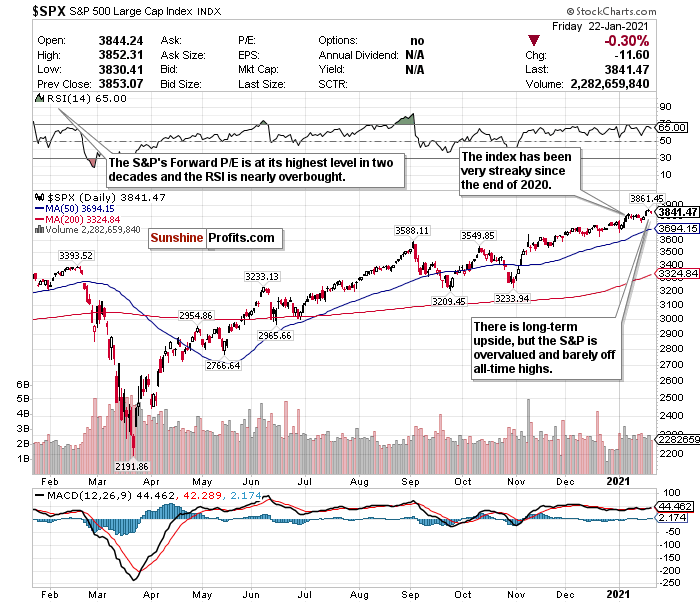
Figure 2- S&P 500 Large Cap Index $SPX
Since December 31st, the S&P has gained just over 2.25%. Despite its winning week last week, what intrigues me about this index is that it seems to go on multiple day winning streaks and losing streaks. After seeing its worst sell-off since October three Mondays ago (Jan. 4), for example, it went on a four-day win streak and broke past 3800. Then the S&P subsequently declined nearly 1% last week.
I am quite concerned about the S&P’s valuations. Although its RSI is not overbought, it is approaching that level. I'm especially concerned about the S&P’s overinflated forward P/E ratio.
Besides this metric, the trailing price/earnings ratio of the median U.S. stock, tracked by Ned Davis Research, has never been higher in history.
Furthermore, based on 2021 forecasts, fewer than ⅓ of S&P 500 trade for under a 15 P/E, the rough long-term average trailing multiple.
I would like to see a more profound drop to around 3600 or below before making a BUY call for the long-term. There is an upside for the second half of 2021, but I would prefer to maximize it from a lower level. Discount shopping can be fun for long-term opportunities.
A short-term correction could inevitably occur by the end of Q1 2021, but for now, I am sticking with the S&P as a HOLD.
For an ETF that attempts to directly correlate with the performance of the S&P, the SPDR S&P ETF (SPY) is a good option.
Small-caps are Too Hot to Handle
Figure 3- iShares Russell 2000 ETF (IWM)
Small-cap stocks, as tracked by the iShares Russell 2000 ETF (IWM), popped again to close out last week. For the week, the IWM gained nearly 2%.
Small-caps are the most likely beneficiaries from a Biden-led aggressive stimulus, and loved what Treasury Secretary Janet Yellen had to say last week.
I love small-cap stocks in the long-term, especially as the world reopens. But the index has overheated by any measurement.
Before January 4, the RSI for the IWM Russell 2000 ETF was at a scorching hot 74.54. I called a sell-off happening in the short-term due to this RSI, and it happened.
After the RSI hit another overbought level of approximately 77 two Wednesdays ago (January 13), the IWM Russell 2000 ETF declined by another 1.5%. I said that Russell stocks would imminently cool down because the RSI was too hot, and precisely that’s what happened.
Nobody knows what will happen during this critical week of earnings and Fed announcements, but we’re firmly above that 70-level again. Stocks don’t just go up in a straight line without experiencing a sharp pullback. This is just the nature of the beast.
So tread lightly.
Consider this too. The Russell, in its entire history as an index, has never traded this high above its 200-day moving average.
Small-caps may have priced in vaccine-related gains by now, and some stimulus optimism may have been priced in too.
I hope small-caps decline before jumping back in for long-term buying opportunities. I love where these stocks could end up by the end of the year.
SELL and take profits if you can- but do not fully exit positions. If there is a deeper pullback, this is a STRONG BUY for the long-term recovery.
Mid-Term/Long-Term
Taiwan, South Korea, and More for Best Emerging Market Exposure
Figure 4- SPY, EWT, ERUS, THD, VNM, EWY, EIDO, ECH, EPU comparison chart- Sep. 1, 2020-Present
If you read my emerging market special last week, you know that I am bullish on emerging markets.
While China’s upside is undeniable, and the MCHI ETF which tracks Chinese equities has outperformed thus far in 2021, it is not the best bet for 2021.
In fact, how in the world is China still considered an emerging market?
As the dollar is weakening and should continue to weaken (more on that later), emerging markets could be perfectly positioned to exploit this and grow in 2021.
PWC also believes that emerging markets (E7) could grow around twice as fast as advanced economies (G7) on average in the coming decades.
For 2021, the following are my BUYs for emerging markets and why:
iShares MSCI Taiwan ETF (EWT)- Developing country, with stable fundamentals, diverse and modern hi-tech economy, regional upside without China’s same geopolitical risks.
iShares MSCI Thailand ETF (THD)- Bloomberg top emerging market pick for 2021 thanks to abundant reserves and a high potential for portfolio inflows. Undervalued compared to other ETFs.
iShares MSCI Russia Capped ETF (ERUS)- Bloomberg second choice for top emerging market in 2021 thanks to robust external accounts, a strong fiscal profile, and an undervalued currency. Red-hot commodity market (big deal for declining dollar), growing hi-tech and software market, growing personal incomes.
VanEck Vectors Vietnam ETF Vietnam (VNM)-Turned itself into an economy with a stable credit rating, strong exports, and modest public debt relative to growth rates. PWC believes Vietnam could also be the fastest-growing economy globally. Could be a Top 20 economy by 2050.
iShares MSCI South Korea ETF (EWY)- Booming economy, robust exports, stable yet high growth potential. ETF has been the top performing emerging market ETF and surged by 148.35% since the market bottomed on March 23rd.
iShares MSCI Indonesia ETF (EIDO)- Largest economy in Southeast Asia with young demographics. Fourth most populous country in the world. Could be less risky than other emerging markets while simultaneously growing fast. Could be a Top 5 economy by 2050.
iShares MSCI Chile ETF (ECH)- One of South America's largest and most prosperous economies. Abundance of natural resources and minerals. World's largest exporter of copper. Could boom thanks to electric vehicles and batteries because of lithium demand. Is the world’s largest exporter of lithium in the world and could have 25% of the world’s reserves.
iShares MSCI Peru ETF (EPU)- Smaller developing economy, but has robust gold and copper reserves and rich mineral resources.
For broad exposure to Emerging Markets, you can also BUY the iShares MSCI Emerging Index Fund (EEM).
Prepare for More Greenback Pain to Come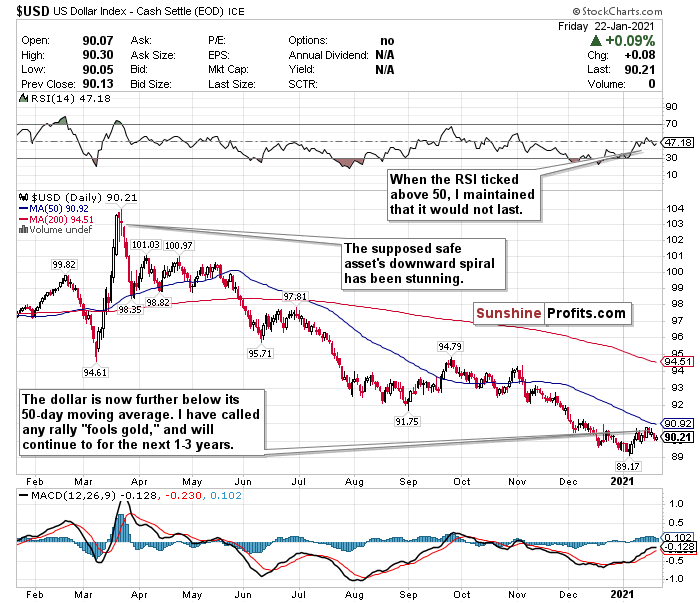
Figure 5- U.S. Dollar $USD
Americans need help and stimulus is necessary and overdue. But the Fed can’t expect to keep printing money and magically hope the U.S. Dollar appreciates.
I still do not see the benefit in running to the greenback as a safe asset. Gold, for example, has been a safe store of value for thousands of years, and has more potential upside in 2021 with trillions of stimulus expected to come.
I’m still calling out the dollar’s weakness after several weeks and expect the decline to pick up steam again thanks to a dovish Fed and multiple headwinds.
Any time the U.S. Dollar has rallied, I’ve called it “fools gold.” So long as policies stay the same, rallies will still be “fools good.”
Incoming Treasury Secretary Janet Yellen’s testimony last week only strengthens my bearish outlook. With Democrats in full control of the government, Biden’s $1.9 trillion stimulus plan could further devalue the dollar.
With inflation possibly creeping back sooner than we realize, the dollar could be entering a typhoon of headwinds.
I also have too many doubts on the effect of interest rates this low for this long, the strengthening of emerging markets, commodity prices, and yes, even cryptocurrencies, to be remotely bullish on the dollar’s prospects over the next 1-3 years.
Meanwhile, the US has nearly $28 trillion of debt, and it’s not going down anytime soon. Some forecasts show that the debt could balloon by over $8 trillion in 2021 too.
According to The Sevens Report, if the dollar falls below 89.13, this could raise the prospect of a further 10.5% decline to the next support level of 79.78 reached in April 2014. We are closer to this point than most realize.
When COVID-19 fears outweigh any other positive sentiments, dollar exposure might be useful since it is a safe harbor. But you can do a whole lot better than the U.S. dollar for safety. Since hitting a nearly 3-year high on March 20th, the dollar has plunged almost 12.6%
Where possible, HEDGE OR SELL USD exposure.
Pay Very Close Attention to Inflation
Pay very close attention to the possible return of inflation within the next 6-12 months. The Fed has said it will allow the GDP to heat up, and it may overshoot in the medium-term as a result. GDP growth may stutter in Q1 2021 but pay close attention to what happens in Q2 and Q3 once vaccines begin to be rolled out on a massive scale. It is only inevitable that inflation will return with the Fed’s policy and projected economic recovery by mid-2021.
The 10-year yield’s recent rally, as well as the 10-year breakeven rate, reflects this as well.
If you are looking to the future to hedge against inflation, look into TIPS, commodities, gold, and potentially some REITs.
In the mid-term, I have BUY calls on the SPDR TIPS ETF (SPIP), the Invesco Optimum Yield Diversified Commodity Strategy No K-1 ETF (PDBC), the SPDR Gold Shares ETF (GLD), and the iShares Cohen & Steers REIT ETF (ICF).
Long-Term
There is so much to worry about in the short-term. But I’m convinced that economic stimulus and the progress made with administering the vaccines bodes well for the second half of 2021. We may be at the beginning of the end of the pandemic-but over the next 1-3 months, this could be a very bumpy ride back.
There does seem to be one consensus though: 2021 could be a big year for stocks.
Small-caps, value stocks, and cyclicals, could especially surge. I just have a much better feeling for them in the second half of the year. I almost hope we see a correction within the first 3 months of 2021. This could be a very strong buying opportunity.
Summary
The current headwinds are very concerning. But I remain optimistic for the second half of 2021 despite the bumpy road there. Until COVID-19 is eradicated, a battle between optimism and pessimism is inevitable.
A short-term correction is likely. But do not let this scare you.
Corrections are NORMAL. What happened last March is ABNORMAL.
The crash and subsequent record-setting recovery we saw in 2020 is a generational occurrence. I can’t see it happening again in 2021. If there is a short-term downturn, take a breath, stay cool, and use it as a time to find buying opportunities. Do not get caught up in fear and most of all:
NEVER TRADE WITH EMOTIONS.
Consider this. Since markets bottomed on March 23rd, ETFs tracking the indices have seen returns like this: Russell 2000 (IWM) up 118.28%. Nasdaq (QQQ) up 91.87%. S&P 500 (SPY) up 73.98%. Dow Jones (DIA) up 68.80%.
In the long-term, markets always end up moving higher and are focused on the future rather than the present.
To sum up all our calls, in the short-term I have a SELL call for:
- The iShares Russell 2000 ETF (IWM) (but do not fully exit positions- trim profits), and
- the Invesco QQQ ETF (QQQ) (but do not fully exit positions- trim profits),
I have a HOLD call for:
- the SPDR S&P ETF (SPY), and
- the SPDR Dow Jones ETF (DIA)
I also have a long-term STRONG BUY call for:
- the iShares Russell 2000 ETF (IWM) BUT IF AND WHEN IT PULLS BACK
For all these ETFs, I am more bullish in the long-term for the second half of 2021.
For the mid-term and long-term, I recommend selling or hedging the US Dollar, and gaining exposure into emerging markets.
I have BUY calls on:
- The iShares MSCI Emerging Index Fund (EEM),
- the iShares MSCI Taiwan ETF (EWT),
- the iShares MSCI Thailand ETF (THD),
- the iShares MSCI Russia ETF (ERUS),
- the VanEck Vectors Vietnam ETF Vietnam (VNM),
- the iShares MSCI South Korea ETF (EWY),
- the iShares MSCI Indonesia ETF (EIDO),
- the iShares MSCI Chile ETF (ECH),
- and the iShares MSCI Peru ETF (EPU)
Additionally, because I foresee inflation returning as early as mid to late 2021…
I also have BUY calls on:
- The SPDR TIPS ETF (SPIP),
- the Invesco Optimum Yield Diversified Commodity Strategy No K-1 ETF (PDBC)
- the SPDR Gold Shares ETF (GLD), and
- the iShares Cohen & Steers REIT ETF (ICF)
Thank you.
Matthew Levy, CFA
Stock Trading Strategist


